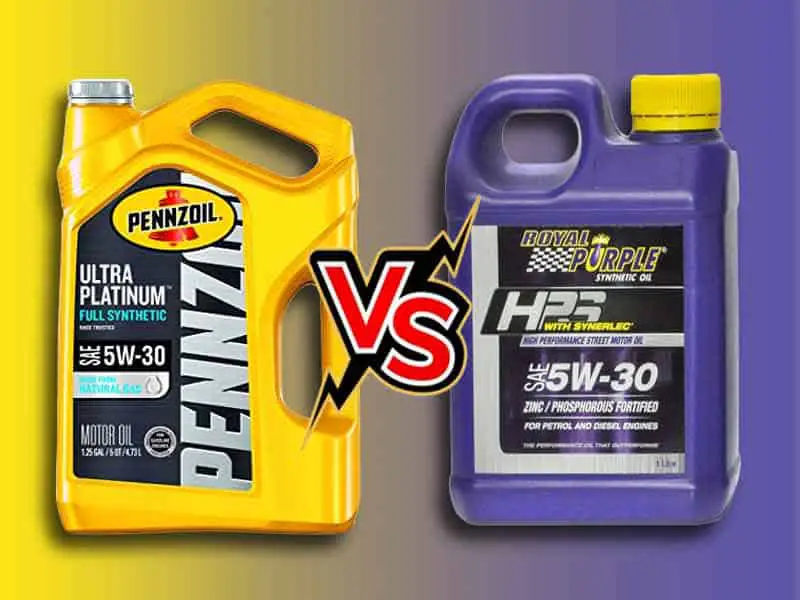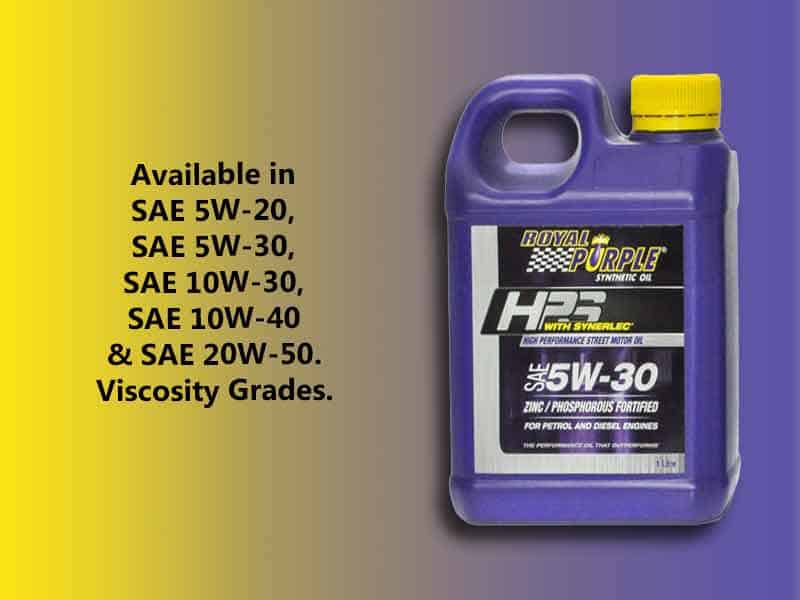Just like it is important to change your car’s engine oil and filter frequently, it is equally imperative to choose the best quality oil out there suited to your vehicle’s needs. Engine oil lubricates the moving parts of the engine that are most vulnerable to friction, like pistons, gear trains, and valves.
Markets are inundated with several types of engine oil: Mineral oils or conventional oils, synthetic oils, synthetic blends, and high-mileage oils. Mineral oils are budget-friendly standard motor oils manufactured from crude oil and refined in a factory. They are more suitable for older vehicle models. Synthetic oils are more refined than conventional oils and manufactured entirely in a factory or lab. They are designed for high-performance or turbocharged engines. Synthetic blends are a mixture of both mineral and synthetic oils. High-mileage oil, as the name suggests, is manufactured for cars with over 75000 miles on their odometer.

Pennzoil Ultra Platinum and Royal Purple are two top-notch, full-synthetic engine oils of the motor oil industry. Pennzoil ultra platinum is made from natural gas using Pureplus technology. This technology converts natural gas, which contains lesser impurities than crude oil, directly into a liquid to be later used as base oil. Pennzoil Ultra Platinum also keeps the pistons 65% cleaner than required by the toughest industry standards.
Royal Purple is a high-performance motor oil known for providing exceptional fuel economy, increasing horsepower by 3-5% than leading conventional and synthetic oils, and reducing friction. With its Sylernec additive technology, Royal purple provides 3 to 4 times better film strength than most oils of similar viscosity.
To make things easier for you, we have done an in-depth comparison between Pennzoil ultra platinum and Royal purple, so that you can make an informed buying decision that you won’t regret later on. So, without further ado, let’s dive into it.
Table of Contents
Comparison at a glance:
To have a quick comparison, have a look at the following differences between Pennzoil ultra Platinum and Royal Purple:
1. Pennzoil Ultra Platinum comes at a lower price, whereas royal purple is more expensive.
2. Royal Purple HPS is created using a blend of premium base oils, while Pennzoil Ultra Platinum is derived from natural gas.
3. Pennzoil Ultra platinum uses its patented Pureplus technology that converts natural gas into a liquid to be used as base oil. Whereas, Royal purple HPS is made using Synelrec additive technology.
4. Royal purple HPS lasts longer than Pennzoil Ultra Platinum. (You may need to change the oil only once or twice a year using Royal Purple, while Pennzoil requires oil change after every 10000 miles).
5.Pennzoil Ultra platinum belongs to Group III of base oils categorized by the American Petroleum Institute (API), while Royal Purple HPS base stock comes from group V.
However, both Pennzoil and Royal Purple HPS are API and ILSAC approved. (API stands for American Petroleum Institute that certifies that engine oil meets or exceeds certain quality and performance standards. ILSAC stands for International Lubricants Standardization and Approval Committee. It is a voluntary licensing and certification program that defines the requirements, parameters, and requirements of lubricants specifications).
Pennzoil Ultra Platinum and Royal Purple :
| Specs | Pennzoil Ultra Platinum | Royal Purple High-Performance Street |
| Oil Type | Full Synthetic | Full Synthetic |
| Engine Type | Compatible with both Diesel and gasoline engines | Compatible with both diesel and gasoline engines. Added compatibility with fuels containing ethanol. |
| Availaible Visocsity Grades | SAE 0W-20, SAE 5W-30, SAE 0W-40, SAE 5W-20, and SAE 10W-30 | SAE 5W-20, SAE 5W-30, SAE 10W-30, SAE 10W-40 and SAE 20W-50. |
| ILSAC | Exceeds ILSAC GF-6A and all previous ILSAC standards | Exceeds GF-5 requirements |
| API | Exceeds the API SP and all previous categories. | Exceeds API SN requirements. |
| Cost | 5 quart (160 fluid ounces) costs $2497. | 5 quart (160 fluid ounces) costs $3286 |
| Oil Change Frequency | Up to 10000 miles without any signs of poor performance. | After every 12000 miles. |
| Additives | Special conditioning seal agents and High-performance additives | Synerlec additive technology and patented ZDDP additives. |
| ACEA | Exceeds the requirements for ACEA A1/B1, A5/B5 | Meets/ or exceeds ACEA A3/B3-04 requirements |
.
Brand Comparison:
Pennzoil was founded in 1913. Pennzoil uses its Patented PurePlus technology to convert natural gas into a liquid to be later used as base oil. It is the official motor oil used in Indycars. Pennzoil manufactures high-mileage oils, synthetic blends, fully synthetic motor oils, and oils for European Vehicles.
Established in 1986, Royal Purple has been winning its spurs in the engine oil market since then. Royal Purple uses Sylernec additive technology to form the best film strength in the industry to protect the engine parts from friction.
Royal Purple is widely used in sprint cars, passenger cars, vans, trucks, land mowers, etc. Among their motor oils, the most popular ones are High-Performance motor oil, API licensed motor oil, and XPR Extreme Performance racing oil.
Lasting Power:
Lasting power is used to evaluate the longevity of engine oil. With Royal purple, you can go well up to 12000 miles without having to fret over changing the oil whereas Pennzoil ultra platinum requires you to change the oil after every 10000 miles or so. So, royal purple is clearly the winner here as it extends oil drain interval which translates into better lasting power and also saves your time and money at the pump.
Certification:
Both Royal Purple HPS motor oil and Pennzoil Ultra Platinum exceed the requirements for API SN, API SN Plus, and ILSAC GF-5 with the latter also exceeding the ACEA A1/B1, A5/B5, and ILSAC GF-6A engine protection and cleansing requirements. They meet the requirements of Chrysler MS 6395, as well as Ford WSS-M2C946. Pennzoil Ultra Platinum is General Motors dexos1 Gen2 certified while Royal purple has GM dexos1 gasoline engine oil approval.
Available SAE Viscosity Grades:

The Society of Automotive Engineers (SAE) developed a scale to define the thickness of oil at high and low temperatures. The viscosity grade is notated with “XW-XX”. Here, W denotes winter, and the number preceding the letter shows the viscosity at 0 F while the number after “W” indicates the thickness of engine oil at 212 F. The lower the viscosity of oil in low temperatures, the more easily it flows, and the higher the viscosity when hot, the thicker the oil is to protect your engine better.
Pennzoil Ultra Platinum comes in the following viscosities:
- 0W-20
- 0W-40
- 5W-20
- 5W-30
- 10W-30
Whereas, Royal Purple HPS motor oil comes in the following viscosity grades:
- 5W-20
- 5W-30
- 10W-30
- 10W-40
- 20W-50

Viscosity index:
Viscosity index tells you about a fluid’s change in thickness relative to temperature change. The higher the viscosity index, the more stable the viscosity of the oil is across a wider temperature range. By using ASTM D2270 tests, the viscosity index of Pennzoil Ultra Platinum (5W-20) and Royal Purple HPS (5W-20) is found to be 224 and 154, respectively. As Pennzoil Ultra Platinum has a higher VI, it provides a more stable lubricating layer across temperature fluctuations.
Pour point:
The pour point of engine oil tells you about the temperature at which the oil starts to thicken and loses its ability to flow.
Pour Point of Royal Purple: -30
Pour Point of Pennzoil Ultra Platinum= -48
The pour point of Pennzoil Ultra Platinum is quite impressive because usually, the temperature doesn’t drop to this level. That means that Pennzoil performs well in colder areas than Royal Purple HPS and can maintain its fluidity even in the lowest of temperatures.
Sludge Build-up:
Deposits of sediments, dirt, and gunk form on the moving parts of your engine because of the degradation of engine oil over time and contaminants. Sludge build-up blocks the oil passages, causes overheating, and reduces the overall engine performance. According to API and ILSAC, the motor oil must limit the total deposit formation to 30mg or less. The Thermo Oxidation Engine Oil Stimulation Test (ASTM D6335) revealed that Pennzoil Ultra Platinum is better at protecting the engine from sludge as its total deposit weight was much less than 10 mg whereas Royal Purple HPS sludge build-up was close to 10 mg.
Protection Against Engine Wear:
Friction, high loads, temperatures, and several other factors can cause the wear and tear of engine parts. like piston rings and cylinders. A four-ball wear test is conducted to evaluate how well a motor oil can protect the engine from wear and tear of friction. In this test, Royal Purple HPS performed well and kept the wear scars below 0.4 mm, whereas with Pennzoil Ultra Platinum, the wear scars ticked above the 0.4 mm mark.
Volatility:
The volatility of engine oil is a measure of its resistance to evaporation under high temperatures. It tells you how easily the lighter molecules “boil off” leaving behind heavier molecules. According to the Noak volatility test (ASTM D5800) (The Noak Volatility test reveals the evaporation loss of lighter molecules and additives at high temperatures.), the volatility of Pennzoil Ultra Platinum is 12.5% and that of Royal Purple HPS is 9.5 (Standard 15 Maximum). So here you can see Royal Purple fares way better than Pennzoil Ultra Platinum, as low volatile Royal Purple does not create viscous drag which translates into greater fuel economy and reduced fuel consumption.
Cost:
A 5 quart (160 fluid ounces) of Royal Purple HPS costs $3286 while the same amount of Pennzoil Ultra Platinum costs $2497. Thus, Royal Purple HPS is pricier than Pennzoil Ultra Platinum.
Our Takeaway:
Both Pennzoil Ultra Platinum and Royal Purple HPS have a prodigious standing in the engine oil market. Their performance is praiseworthy and they deliver value to their consumers. We have provided you with a comprehensive comparison between the two motor oils. If you are on a budget, go for Pennzoil ultra Platinum as Royal Purple HPS is on the expensive end of the spectrum. If better fuel economy and reduced oil consumption is your priority chosen Royal Purple HPS as it extends oil drain intervals by 12000 miles.
But as you know your engine best, the final decision is up to you. Remember to always consult your vehicle’s manufacturer’s manual to buy the motor oil that best matches your engine’s needs.